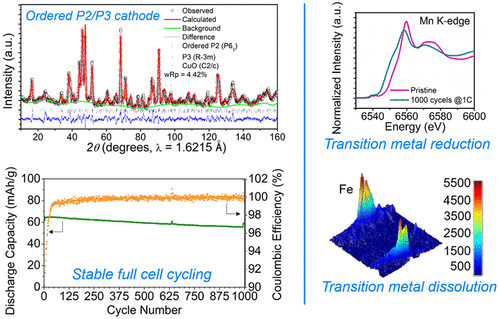当前位置:
X-MOL 学术
›
ACS Mater. Lett.
›
论文详情
Our official English website, www.x-mol.net, welcomes your
feedback! (Note: you will need to create a separate account there.)
An Ordered P2/P3 Composite Layered Oxide Cathode with Long Cycle Life in Sodium-Ion Batteries
ACS Materials Letters ( IF 9.6 ) Pub Date : 2019-10-22 , DOI: 10.1021/acsmaterialslett.9b00347 Muhammad Mominur Rahman 1 , Jing Mao 2 , Wang Hay Kan 3, 4 , Cheng-Jun Sun 5 , Luxi Li 5 , Yan Zhang 2, 6 , Maxim Avdeev 4, 7 , Xi-Wen Du 2 , Feng Lin 1
ACS Materials Letters ( IF 9.6 ) Pub Date : 2019-10-22 , DOI: 10.1021/acsmaterialslett.9b00347 Muhammad Mominur Rahman 1 , Jing Mao 2 , Wang Hay Kan 3, 4 , Cheng-Jun Sun 5 , Luxi Li 5 , Yan Zhang 2, 6 , Maxim Avdeev 4, 7 , Xi-Wen Du 2 , Feng Lin 1
Affiliation

|
Developing stable cathode materials represents a crucial step toward long-life sodium-ion batteries. P2-type layered oxides are important as cathodes for their reversibility, but their long-term performance in full cells remains a key challenge. Herein, we report Na0.75Co0.125Cu0.125Fe0.125Ni0.125Mn0.5O2 with an intergrowth of ordered P2 and P3 phases, studied by neutron diffraction and Rietveld refinement. A stable electrochemical performance is achieved in Na half cells with 100% capacity retention at a rate of C/10 after 100 cycles (initial capacity of 90 mAh/g), 96% capacity retention at a rate of 1 C after 500 cycles (initial capacity of 70 mAh/g), and 85% capacity retention at a rate of 5 C after 1000 cycles (initial capacity of 55 mAh/g). Stable full cell performance is achieved with 84.2% capacity retention after 1000 cycles at a rate of 1 C. Synchrotron X-ray diffraction, spectroscopy, and imaging are applied to elucidate the relationship between chemical/structural evolution and battery performance. A reversible local and global structural evolution is observed during initial cycles. Meanwhile, the challenges with enabling prolonged cycling (beyond 1000 cycles) may be associated with Fe dissolution and formation of a copper oxide phase. This study implies that cathodes with complex chemical and structural formations may stabilize electrochemical performance and highlights the importance of decoupling the contribution of each transition metal to performance degradation.
中文翻译:

在钠离子电池中具有长循环寿命的有序P2 / P3复合层状氧化物阴极
开发稳定的阴极材料代表了长寿命钠离子电池的关键一步。P2型层状氧化物因其可逆性而作为阴极非常重要,但它们在全电池中的长期性能仍然是关键挑战。在此,我们报告Na 0.75 Co 0.125 Cu 0.125 Fe 0.125 Ni 0.125 Mn 0.5 O 2通过中子衍射和Rietveld精炼研究了有序P2和P3相的共生。在Na半电池中获得了稳定的电化学性能,在100次循环后(C / 10的初始容量为90 mAh / g)以100%的容量保持100%的容量(初始循环为90 C / 96%的容量以1 C的速率保持了96%的容量) 1000次循环后,以5 C的速率保留85%的容量(初始容量为55 mAh / g)。以1 C的速率在1000次循环后,具有84.2%的容量保持率,可实现稳定的全电池性能。应用同步加速器X射线衍射,光谱学和成像技术来阐明化学/结构演变与电池性能之间的关系。在初始周期中观察到可逆的局部和整体结构演变。同时,延长循环(超过1000个循环)的挑战可能与铁的溶解和氧化铜相的形成有关。这项研究表明,具有复杂化学和结构形成的阴极可以稳定电化学性能,并强调了将每种过渡金属对性能下降的贡献去耦的重要性。
更新日期:2019-10-25
中文翻译:

在钠离子电池中具有长循环寿命的有序P2 / P3复合层状氧化物阴极
开发稳定的阴极材料代表了长寿命钠离子电池的关键一步。P2型层状氧化物因其可逆性而作为阴极非常重要,但它们在全电池中的长期性能仍然是关键挑战。在此,我们报告Na 0.75 Co 0.125 Cu 0.125 Fe 0.125 Ni 0.125 Mn 0.5 O 2通过中子衍射和Rietveld精炼研究了有序P2和P3相的共生。在Na半电池中获得了稳定的电化学性能,在100次循环后(C / 10的初始容量为90 mAh / g)以100%的容量保持100%的容量(初始循环为90 C / 96%的容量以1 C的速率保持了96%的容量) 1000次循环后,以5 C的速率保留85%的容量(初始容量为55 mAh / g)。以1 C的速率在1000次循环后,具有84.2%的容量保持率,可实现稳定的全电池性能。应用同步加速器X射线衍射,光谱学和成像技术来阐明化学/结构演变与电池性能之间的关系。在初始周期中观察到可逆的局部和整体结构演变。同时,延长循环(超过1000个循环)的挑战可能与铁的溶解和氧化铜相的形成有关。这项研究表明,具有复杂化学和结构形成的阴极可以稳定电化学性能,并强调了将每种过渡金属对性能下降的贡献去耦的重要性。











































 京公网安备 11010802027423号
京公网安备 11010802027423号